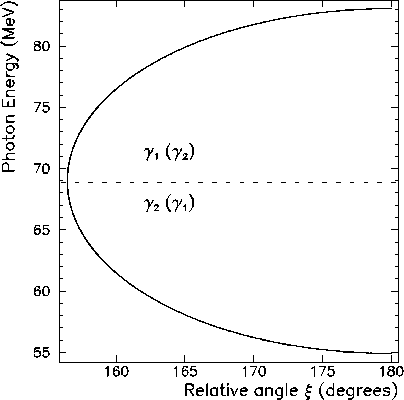In the rest (primed) frame of the ![]() , the
, the ![]() decay produces
two anticollinear photons, as shown in Fig. 1.1. In order to calculate
the momenta of the photons in the lab frame, one must perform the appropriate
transformation. For this purpose, the momentum of the
decay produces
two anticollinear photons, as shown in Fig. 1.1. In order to calculate
the momenta of the photons in the lab frame, one must perform the appropriate
transformation. For this purpose, the momentum of the ![]() in the lab (unprimed)
frame is defined to be in the x direction. Consequently, the boost from the
primed frame to the lab frame is along the negative x direction, as shown in
Fig. 1.1.
in the lab (unprimed)
frame is defined to be in the x direction. Consequently, the boost from the
primed frame to the lab frame is along the negative x direction, as shown in
Fig. 1.1.

Figure 1.1: Decay of a neutral pion into two photons, in the rest (primed) frame of
the pion.
In the primed frame, the four-momenta of the two photons take the form:
![]()
where ![]() MeV.
Transforming to the lab (unprimed) frame with a boost in the negative x direction
for
MeV.
Transforming to the lab (unprimed) frame with a boost in the negative x direction
for ![]() ,
,

and

From the above expressions for ![]() and
and ![]() in the lab frame, one
can see that the energy and momenta of the two photons are completely
determined by the angle
in the lab frame, one
can see that the energy and momenta of the two photons are completely
determined by the angle ![]() in the primed frame. Because the
probability of values for the angle
in the primed frame. Because the
probability of values for the angle ![]() is uniform from 0
is uniform from 0![]() to 180
to 180![]() , the spectrum of energies for the two photons forms
a flat ``box'' spectrum, ranging from the minimum to the maximum
allowed values.
, the spectrum of energies for the two photons forms
a flat ``box'' spectrum, ranging from the minimum to the maximum
allowed values.
The relative
angle ![]() between the two photons can be calculated from the general
formula for the angle
between the two photons can be calculated from the general
formula for the angle ![]() between two vectors A and B,
between two vectors A and B,
![]()
As a result, the expression for ![]() takes the form
takes the form

Finally, the energy of one photon in the lab frame is plotted against ![]() in Fig. 1.2. From the graph, one can see that the photon energies
in the lab frame range from 54.9 MeV to 83.0 MeV.
in Fig. 1.2. From the graph, one can see that the photon energies
in the lab frame range from 54.9 MeV to 83.0 MeV.

Figure 1.2: Energy spectrum for photons from the decay ![]() plotted against the relative angle
plotted against the relative angle ![]() between the two photons, all in the lab
frame.
between the two photons, all in the lab
frame.